National Register of Historic Places listings in Wasco County, Oregon

Location of Wasco County in Oregon
This list presents the full set of buildings, structures, objects, sites, or districts designated on the National Register of Historic Places in Wasco County, Oregon, and offers brief descriptive information about each of them. The National Register recognizes places of national, state, or local historic significance across the United States.[1] Out of over 90,000 National Register sites nationwide,[2] Oregon is home to over 2,000,[3] and 34 of those are found partially or wholly in Wasco County.
- This National Park Service list is complete through NPS recent listings posted December 2, 2016.[4]
Current listings
| [5] | Name on the Register | Image | Date listed[6] | Location | City or town | Description |
|---|---|---|---|---|---|---|
| 1 | Lewis Anderson House, Barn and Granary |  |
(#80003387) |
508 W. 16th Street 45°35′44″N 121°11′52″W / 45.595678°N 121.197787°W |
The Dalles | This well-preserved ensemble of 1890s Swedish American vernacular architecture was originally located on Pleasant Ridge, south of The Dalles. The buildings were relocated in 1972 to restore and protect them, and have been managed as a house museum since that time.[7] |
| 2 | Antelope School |  |
(#16000347) |
45500 McGreer Street 44°54′47″N 120°43′26″W / 44.913098°N 120.723844°W |
Antelope | |
| 3 | Balch Hotel | 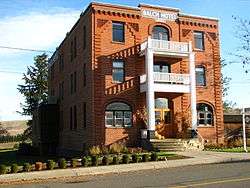 |
(#87001469) |
40 S. Main Street 45°27′02″N 121°07′53″W / 45.450444°N 121.131250°W |
Dufur | This hotel was built in 1908 to serve travelers connecting between the railroad and stagecoaches. Its advanced amenities and the regular presence of salesmen made it a center of the Dufur community. Its fortunes declined with the Great Depression and the failure of the railroad, but it has remained in continuous use to the present.[8] |
| 4 | Barlow Road | 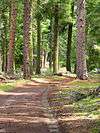 |
(#92000334) |
Mount Hood National Forest[lower-alpha 1] 45°13′50″N 121°34′47″W / 45.23065°N 121.5797°W |
Wamic to Rhododendron | Beginning with its construction by Sam Barlow in 1846, this toll road provided the first overland connection for wagons between The Dalles and Oregon City over Mount Hood, and offered a majority of Oregon Trail emigrants an alternative to the hazardous raft passage down the Columbia River from The Dalles to Fort Vancouver.[9][10] |
| 5 | Bennett–Williams House | 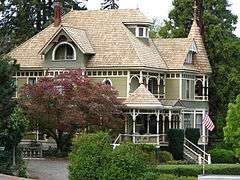 |
(#86000291) |
608 W. 6th Street 45°36′09″N 121°11′35″W / 45.602516°N 121.193113°W |
The Dalles | Built in 1899 for prominent local lawyer, judge, and Oregon Supreme Court justice Alfred S. Bennett, this house is the most outstanding and best preserved example of Queen Anne architecture in The Dalles. It later became the home of Edward M. Williams, a notable local merchant.[11] |
| 6 | Columbia River Highway Historic District | _(wascDA0056).jpg) |
(#83004168) |
Roughly along the south side of the Columbia River[lower-alpha 2] 45°40′56″N 121°18′01″W / 45.682219°N 121.300139°W |
The Dalles to Troutdale | Constructed between 1913 and 1922, this was the first scenic highway in the United States. Designed specifically to provide visitors access to the most outstanding of the scenic features of the Columbia River Gorge, the highway is also an outstanding example of modern highway development for its pioneering advances in road engineering.[12][13] |
| 7 | Columbia Southern Hotel | |
(#79002150) |
4th and E Streets 45°00′13″N 120°45′10″W / 45.003705°N 120.752813°W |
Shaniko | Built by the Columbia Southern Railway in 1900–1902 at the southern terminus of its line, this hotel is the most imposing structure in Shaniko. It was the hub of the community during the heyday of the local wool industry in the early 20th century. In addition to lodging, it served as saloon, bank, stage stop, dance hall, and general gathering place.[14] |
| 8 | First Wasco County Courthouse | 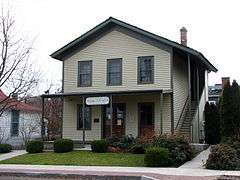 |
(#98000260) |
410 W. 2nd Place 45°36′13″N 121°11′19″W / 45.603632°N 121.188554°W |
The Dalles | One of only two remaining courthouses from prior to Oregon statehood, this building served Wasco County from 1859 until 1882, and then as The Dalles city hall until 1907. From its original downtown location, it has been moved several times before its current location.[15] |
| 9 | Fivemile Rapids Site (35 WS 4) | 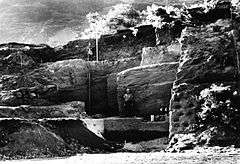 |
(#74001719) |
Address restricted[lower-alpha 3][16] |
The Dalles | Yielding remains beginning soon after the end of the last glacial period, this archeological site (along with other nearby sites) provides a nearly continuous record of human occupation from at least 9000 BCE to 1820 CE. It also provides some of the earliest available evidence of fishing in human economy.[17] |
| 10 | Fort Dalles Surgeon's Quarters |  |
(#71000682) |
15th and Garrison Streets 45°35′46″N 121°11′50″W / 45.596130°N 121.197283°W |
The Dalles | The U.S. Army built this Gothic Revival-style house ca. 1857 to serve the medical officer of Fort Dalles. The Army occupied Fort Dalles from 1850 to 1867,[lower-alpha 4] using it as a base of operations for the northwest Indian Wars. The Surgeon's Quarters, which became a museum in 1905, is one of only two surviving structures from Fort Dalles.[19][20] |
| 11 | Edward French House | 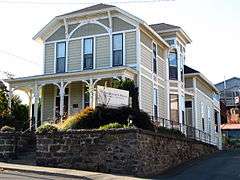 |
(#92001319) |
515 Liberty Street 45°36′04″N 121°11′14″W / 45.601168°N 121.187339°W |
The Dalles | Originally built ca. 1865, this home was acquired by the French family in 1892 and renovated in the Italianate style ca. 1900. Edward French, with his uncle Daniel and other family members, were prominent bankers and businessmen from early The Dalles until the 1920s.[21] |
| 12 | Fulton–Taylor House | 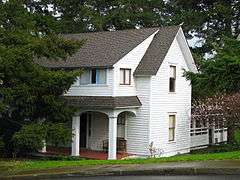 |
(#93000920) |
704 Case Street 45°35′52″N 121°11′02″W / 45.597913°N 121.183966°W |
The Dalles | Built ca. 1858, this house was later occupied by two figures important in The Dalles. James Fulton (in residence 1864–1881), an American emigrant, became a rancher, militia leader, and state legislator. The Rev. O. D. Taylor (in residence 1891–1897) led a long-running but failed real estate scheme that was widely regarded as fraudulent.[22] |
| 13 | Hugh Glenn House | 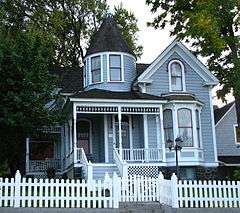 |
(#91000064) |
100 W. 9th Street 45°35′52″N 121°11′20″W / 45.597883°N 121.188883°W |
The Dalles | This is one of the most notable and historically well-preserved Queen Anne-style houses in The Dalles. Hugh Glenn, a prominent architect and businessman in The Dalles, designed and built the house around 1882 and lived there until his death in 1927.[23] |
| 14 | Heimrich–Seufert House |  |
(#90000827) |
303 E. 10th Street 45°35′48″N 121°11′10″W / 45.596722°N 121.186110°W |
The Dalles | This 1927 Tudor Revival house was home to two prominent figures in commerce and industry in The Dalles. John G. Heimrich (in residence 1927–1931) was a leader in the development of short line railroads in Oregon. Edward Seufert (in residence 1933–1966) managed his family's locally important salmon cannery.[24] |
| 15 | Orlando Humason House |  |
(#91000809) |
908 Court Street 45°35′51″N 121°11′13″W / 45.597573°N 121.186960°W |
The Dalles | Orlando Humason, the "Father of Wasco County", lived in this modest house from its construction in 1860 until his death in 1875. In the territorial and state legislatures, he introduced legislation establishing Wasco and Multnomah counties, and the City of The Dalles. He also championed construction of the Cascade Locks.[25] |
| 16 | Imperial Stock Ranch Headquarters Complex |  |
(#94000808) |
Hinton Road 45°05′55″N 120°47′22″W / 45.098553°N 120.789463°W |
Shaniko vicinity | |
| 17 | Indian Shaker Church and Gulick Homestead | 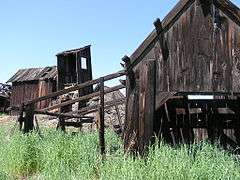 |
(#78003087) |
Near the junction of Interstate 84 and U.S. Route 197 45°36′21″N 121°08′08″W / 45.605827°N 121.135619°W |
The Dalles | The only remaining 19th century fishing homestead in Oregon, this complex was built by Henry Gulick on the Columbia riverbank in the 1890s. He included a church for his wife, Harriet, a member of the Wasco people. The church was the smallest of five Indian Shaker Church congregations in the state.[26] |
| 18 | Joseph D. and Margaret Kelly House | 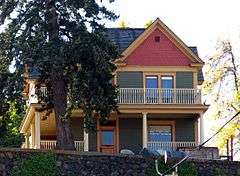 |
(#99000641) |
921 E. 7th Street 45°35′51″N 121°10′41″W / 45.597436°N 121.178181°W |
The Dalles | Joseph Kelly, a successful farmer during the establishment of wheat as a cash crop in Wasco County, built and retired to this house in 1908. He and his wife Margaret became prominent local philanthropic figures. The house is also notable for its unusual vernacular rendering of the Queen Anne style.[27] |
| 19 | Maupin Section Foreman's House |  |
(#06001082) |
601 Deschutes Access Road 45°10′06″N 121°05′04″W / 45.168406°N 121.084378°W |
Maupin | This house recalls the "Last Great Railroad War" between transport barons E. H. Harriman and James J. Hill, as they raced to build routes up the Deschutes River canyon to Central Oregon. Harriman's company built the house to Union Pacific standard plans in 1910 to house the local track maintenance foreman.[lower-alpha 5][28] |
| 20 | Malcolm A. Moody House |  |
(#80003388) |
300 W. 13th Street 45°35′47″N 121°11′37″W / 45.596422°N 121.193500°W |
The Dalles | Believed to have been built in 1850 for noncommissioned officers at Camp Drum,[lower-alpha 4] this house may be the oldest remaining building in The Dalles. It was later occupied by mayor and U.S. Representative Malcolm A. Moody, and ultimately became a museum.[29][30] |
| 21 | Jefferson Mosier House | 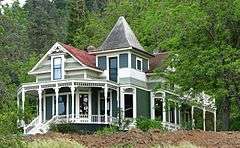 |
(#90000286) |
704 3rd Avenue 45°40′56″N 121°23′43″W / 45.682287°N 121.395160°W |
Mosier | Jefferson N. Mosier (1860–1928) first platted the town of Mosier in 1902 on what had been his father's donation land claim and promoted it for decades after. He built this prominent house in 1904, where he resided until his death. It is the only Queen Anne building in Mosier, and features many signature characteristics of the type.[31] |
| 22 | Mosier Mounds Complex | 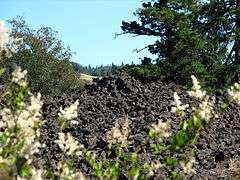 |
(#03000053) |
Address restricted[lower-alpha 3][16] |
Mosier | This collection of stone walls, pits, and mounds amid a basalt talus slope is the largest and most complex of a number of similar Native American sites in the southern Columbia Plateau. The site predates the arrival of Europeans and probably the local ascendance of Chinookan peoples, but has resisted more precise dating or cultural affiliation.[32] |
| 23 | Dr. J. A. Reuter House | 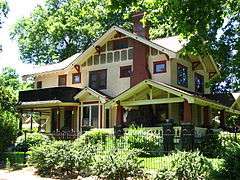 |
(#97000578) |
420 E. 8th Street 45°35′49″N 121°10′59″W / 45.596845°N 121.182984°W |
The Dalles | John Alexander Reuter (1876–1954) practiced medicine in The Dalles for 44 years, joining a partnership that established the city's first hospital (1901) and nursing school. He bought this house in 1909 and transformed it into the city's finest example of the Craftsman style.[33] |
| 24 | Rock Fort Campsite | 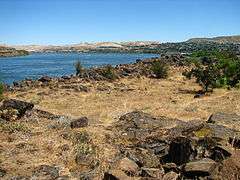 |
(#80003389) |
W. 1st Street, at the Columbia River shore 45°36′25″N 121°11′17″W / 45.60705°N 121.1881°W |
The Dalles | The Lewis and Clark Expedition camped at this natural riverside fortification for three nights in 1805, just after passing Celilo Falls on its descent to the Pacific, and again for one night on its return journey. Here the expedition first made significant contact and commerce with the Chinookan-speaking peoples of the lower Columbia.[34][35] |
| 25 | St. Peter's Roman Catholic Church | _(wascDA0027a).jpg) |
(#74001720) |
3rd and Lincoln Streets 45°36′10″N 121°11′15″W / 45.602747°N 121.187618°W |
The Dalles | The Dalles' original Catholic parish, established in 1848, outgrew its second church by 1890. This building was constructed in 1898 based on Otto Kleemann's adaptation of plans imported from Germany. Upon its completion, it was considered the finest Catholic church in Oregon. The 1898 building became a museum in the 1960s.[36] |
| 26 | Shaniko Historic District | 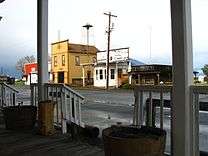 |
(#82003754) |
U.S. Route 97 and Oregon Route 218 45°00′15″N 120°45′09″W / 45.00417°N 120.7525°W |
Shaniko | |
| 27 | Edward F. Sharp Residential Ensemble |  |
(#91001561) |
400 and 404 E. 4th Street and 504 Federal Street 45°35′57″N 121°10′55″W / 45.599113°N 121.181850°W |
The Dalles | Edward Sharp (1865–1954) was the county surveyor and roadmaster whose work underlies much of the development in Wasco County. He built this trio of houses (1895–1905) for himself, his family, and their employees in the Queen Anne and Craftsman styles.[37] |
| 28 | The Dalles Carnegie Library | _(wascD0089).jpg) |
(#78002325) |
220 E. 4th Street 45°36′00″N 121°11′01″W / 45.599983°N 121.183617°W |
The Dalles | This Beaux-Arts style Carnegie library was built in 1910 with a $10,000 grant. It was The Dalles' first public library and provided the seed for a small cluster of civic buildings, including the county courthouse and civic auditorium. In 1966, the library moved to a new facility and the Carnegie building became an arts center.[38] |
| 29 | The Dalles Civic Auditorium | 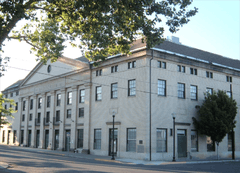 |
(#78002326) |
323 E. 4th Street 45°35′59″N 121°10′56″W / 45.599796°N 121.182098°W |
The Dalles | Dedicated in 1921 as The Dalles' memorial to veterans of World War I, this was also one of the earliest community centers in Oregon to serve multiple recreational needs. It housed an auditorium, gymnasium, ballroom, fireside reception room, and (briefly) a swimming pool.[39] |
| 30 | The Dalles Commercial Historic District |  |
(#86002953) |
Roughly bounded by Interstate 84 and Laughlin, 5th, and Union Streets 45°36′04″N 121°11′00″W / 45.601064°N 121.183360°W |
The Dalles | Strategically located at the eastern end of the Columbia River Gorge, The Dalles became the hub of the interior Northwest in the 19th and early 20th centuries. The buildings of the historic district, built between 1860 and 1938,[lower-alpha 6] reflect the city's status and evolution as the commercial, governmental, and cultural center of Eastern Oregon.[40] |
| 31 | John L. Thompson House | 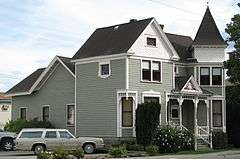 |
(#80003390) |
209 W. 3rd Street 45°36′10″N 121°11′11″W / 45.602677°N 121.186307°W |
The Dalles | John Thompson, an emigrant and successful blacksmith, built his house in 1889 in a simple vernacular style. It underwent a major expansion in 1897 to become a prominent, Queen Anne residence. It represents the evolution of architecture in frontier towns, and is one of The Dalles' outstanding examples of the Queen Anne style.[41] |
| 32 | Trevitt's Addition Historic District |  |
(#95000686) |
Roughly bounded by 2nd, Liberty, and 6th Streets and Mill Creek 45°36′09″N 121°11′24″W / 45.60262°N 121.19°W |
The Dalles | Victor Trevitt platted this first expansion of the original 1855 "Dalles City" townsite in 1860. The addition saw the first flour mill and electrical and water systems in The Dalles, and direct connection to important highway and rail networks. Surviving buildings in the district, primarily residential, reflect a spectrum of architectural styles from 1864 to 1937.[42] |
| 33 | U.S. Post Office | _-_The_Dalles_Oregon.jpg) |
(#85000545) |
100 W. 2nd Street 45°36′09″N 121°11′05″W / 45.602377°N 121.184587°W |
The Dalles | Built in 1916 from standardized federal plans in the Greek Revival style, this was the first federal building in The Dalles and one of a set of nine built in Oregon in the 1910s. It remained in operation as a post office longer than seven of the other eight in that group.[43] |
| 34 | John and Murta Van Dellen House | 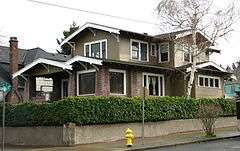 |
(#91000063) |
400 E. 8th Street 45°35′50″N 121°11′02″W / 45.597112°N 121.183810°W |
The Dalles | Built in 1920, this is the outstanding example of a California bungalow in The Dalles. Original owner John Van Dellen was a prosperous lumber yard owner, and made use of the finest local building materials and craftsmanship in constructing his house.[44] |
See also
- National Register of Historic Places listings in Oregon
- Listings in neighboring counties: Clackamas, Gilliam, Hood River, Jefferson, Klickitat, Marion, Sherman, Wheeler
- List of National Historic Landmarks in Oregon
- Historic preservation
- History of Oregon
- Lists of Oregon-related topics
Notes
- ↑ The Barlow Road is a linear district that runs north of and roughly parallel to the line of the White and Salmon rivers from southwest of Wamic to Rhododendron. See also Hood River and Clackamas counties.
- ↑ The Columbia River Highway Historic District is a linear district with the Chenoweth Creek Bridge, The Dalles, at its east end, and the Sandy River Bridge, Troutdale, at the west end. See also Hood River and Multnomah counties.
- 1 2 Federal and state laws and practices restrict general public access to information regarding the specific location of sensitive archeological sites in many instances. The main reasons for such restrictions include the potential for looting, vandalism, or trampling.
- 1 2 The Army established Camp Drum in 1850. The post became Fort Drum and then Fort Dalles in 1853.[18]
- ↑ Most of Harriman's tracks and stations in the Deschutes canyon were abandoned in 1936. The other two buildings of the Maupin station, the depot and the maintenance crew bunk, were demolished by 1968.
- ↑ The district's 1997 National Register nomination file listed the Port of The Dalles Grain Elevator, built in 1942, as a contributing resource in the district. However the grain elevator was subsequently removed, leaving 1938 as the most recent date of construction of a contributing building.
References
- ↑ Andrus, Patrick W.; Shrimpton, Rebecca H.; et al. (2002), How to Apply the National Register Criteria for Evaluation, National Register Bulletin (15), National Park Service, U.S. Department of the Interior, OCLC 39493977, archived from the original on April 6, 2014, retrieved June 20, 2014.
- ↑ National Park Service, National Register of Historic Places Program: Research, archived from the original on February 1, 2015, retrieved January 28, 2015.
- ↑ Oregon Parks and Recreation Department, Oregon Historic Sites Database, retrieved August 6, 2015. Note that a simple count of National Register records in this database returns a slightly higher total than actual listings, due to duplicate records. A close reading of detailed query results is necessary to arrive at the precise count.
- ↑ "National Register of Historic Places: Weekly List Actions". National Park Service, United States Department of the Interior. Retrieved on December 2, 2016.
- ↑ Numbers represent an ordering by significant words. Various colorings, defined here, differentiate National Historic Landmarks and historic districts from other NRHP buildings, structures, sites or objects.
- ↑ The eight-digit number below each date is the number assigned to each location in the National Register Information System database, which can be viewed by clicking the number.
- ↑ Seufert, Gladys (March 12, 1979), National Register of Historic Places Inventory — Nomination Form: Anderson, Lewis, House, Barn and Granary (PDF), retrieved February 23, 2012.
- ↑ Green, Patricia L. (November 28, 1986), National Register of Historic Places Inventory — Nomination Form: Balch Hotel (PDF), retrieved February 18, 2012.
- ↑ Beckham, Stephen Dow (October 1989), National Register of Historic Places Registration Form: Barlow Road (PDF), retrieved July 30, 2014.
- ↑ Clackamas Heritage Partners (February 1, 2013), "Final Leg", Historic Oregon City, retrieved July 23, 2014.
- ↑ Williams, E. D. (August 14, 1985), National Register of Historic Places Inventory — Nomination Form: Bennett–Williams House (PDF), retrieved July 16, 2014.
- ↑ Smith, Dwight A. (October 3, 1983), National Register of Historic Places Inventory — Nomination Form: Columbia River Highway Historic District (PDF), OCLC 12786411, retrieved July 15, 2014.
- ↑ National Park Service, National Historic Landmark Program: NHL Database, retrieved July 15, 2014.
- ↑ Luckman, Katharina L. (January 1979), National Register of Historic Places Inventory — Nomination Form: Columbia Southern Hotel (PDF), retrieved July 15, 2014.
- ↑ Potter, Elisabeth Walton (January 16, 1998), National Register of Historic Places Registration Form: First Wasco County Courthouse (PDF), retrieved June 7, 2014.
- 1 2 Knoerl, John; Miller, Diane; Shrimpton, Rebecca H. (1990), Guidelines for Restricting Information about Historic and Prehistoric Resources, National Register Bulletin (29), National Park Service, U.S. Department of the Interior, OCLC 20706997.
- ↑ Cole, D. L. (August 16, 1974), National Register of Historic Places Inventory — Nomination Form: Fivemile Rapids Site.
- ↑ National Park Service (n.d.), Military & Supply Forts on the Oregon Trail (PDF) (brochure), retrieved June 18, 2014.
- ↑ Walton, Elisabeth (July 1971), National Register of Historic Places Inventory — Nomination Form: Fort Dalles Surgeon's Quarters (PDF), retrieved February 4, 2013.
- ↑ Wasco County Museum Commission (2010), "Fort Dalles Museum", Fort Dalles Museum and the Anderson Homestead, retrieved February 4, 2013.
- ↑ Mlnarik-Holt, Jan (March 15, 1992), National Register of Historic Places Registration Form: French, Edward, House (PDF), retrieved June 18, 2014.
- ↑ Cheung, Jacqueline; Gleason, Eric (January 20, 1993), National Register of Historic Places Registration Form: Fulton–Taylor House (PDF), retrieved February 18, 2012.
- ↑ Dennerline, Gary R.; Dennerline, Bette B. (December 31, 1990), National Register of Historic Places Registration Form: Glenn, Hugh, House (PDF), retrieved January 17, 2014.
- ↑ Dodds, Linda S. (December 13, 1989), National Register of Historic Places Registration Form: Heimrich–Seufert House (PDF), retrieved March 4, 2012.
- ↑ Mlnarik-Holt, Jan; Meader, Dan (November 15, 1990), National Register of Historic Places Registration Form: Humason, Orlando, House (PDF), retrieved February 4, 2013.
- ↑ Sutton, Robert K. (February 19, 1976), National Register of Historic Places Inventory — Nomination Form: Indian Shaker Church and Gulick Homestead (PDF), retrieved December 24, 2013.
- ↑ Donovan, Sally (November 29, 1998), National Register of Historic Places Registration Form: Joseph D. and Margaret Kelly Residence (PDF), retrieved April 16, 2014.
- ↑ Hall, Michael A. (October 2007), National Register of Historic Places Registration Form: Maupin Section Foreman's House (PDF), retrieved April 26, 2014.
- ↑ Seufert, Gladys; Potter, Elisabeth Walton (January 1980), National Register of Historic Places Inventory — Nomination Form: Moody, Malcolm A., House (PDF), retrieved June 18, 2014.
- ↑ Wasco County Historical Society (2012), Wasco County Historical Society and the Rorick House, retrieved June 18, 2014.
- ↑ Donovan, Sally (August 12, 1989), National Register of Historic Places Registration Form: Mosier, Jefferson, House (PDF), retrieved July 15, 2014.
- ↑ Anderson, Kirsten J.; Connolly, Tom (November 20, 2001), National Register of Historic Places Registration Form: Mosier Mounds Complex.
- ↑ Little, Sonja (November 15, 1996), National Register of Historic Places Registration Form: Reuter, Dr. J. A., House (PDF), retrieved July 12, 2014.
- ↑ Ambrose, Stephen E. (1996), Undaunted Courage: Meriwether Lewis, Thomas Jefferson, and the Opening of the American West, New York: Simon & Schuster, pp. 305–307, ISBN 978-0-684-82697-4.
- ↑ Seufert, Gladys; Potter, Elisabeth Walton; Chuinard, E.G. (October 1979), National Register of Historic Places Inventory — Nomination Form: Rock Fort Campsite (PDF).
- ↑ Hartwig, Paul B. (August 1973), National Register of Historic Places Inventory — Nomination Form: St. Peter's Roman Catholic Church (PDF), retrieved February 28, 2013.
- ↑ Schroeder, David H.; Schroeder, Barbara L. (February 7, 1991), National Register of Historic Places Registration Form: Sharp, Edward F., Residential Ensemble (PDF), retrieved June 23, 2014.
- ↑ Hopkins, Mark (March 10, 1978), National Register of Historic Places Inventory — Nomination Form: The Dalles Carnegie Library (PDF), retrieved December 12, 2014.
- ↑ Krier, Jean; Nugent, Joan; Baker, Phyllis; Wundrum, Edward C. (March 12, 1978), National Register of Historic Places Inventory — Nomination Form: Dalles Civic Auditorium (PDF), retrieved April 28, 2012.
- ↑ Dodds, Linda; Schneider, Ted; Donovan, Sally (August 1997), National Register of Historic Places Registration Form: The Dalles Commercial Historic District (1997 Update) (PDF), retrieved August 31, 2014.
- ↑ Bailey, Barbara (March 20, 1980), National Register of Historic Places Inventory — Nomination Form: Thompson, John L. House (PDF), retrieved April 26, 2014.
- ↑ Donovan, Sally; Howard, Bruce (July 30, 1994), National Register of Historic Places Registration Form: Trevitt's Addition Historic District (PDF).
- ↑ Kolva, H. J. (August 31, 1984), National Register of Historic Places Inventory — Nomination Form: U.S. Post Office, The Dalles, Oregon (PDF), retrieved August 2, 2013.
- ↑ Krauss, Fred D. (August 1990), National Register of Historic Places Registration Form: Van Dellen, John and Murta, House (PDF), retrieved April 28, 2012.
External links
- Oregon Parks and Recreation Department, National Register Program
- National Park Service, National Register of Historic Places site
 Media related to National Register of Historic Places in Wasco County, Oregon at Wikimedia Commons
Media related to National Register of Historic Places in Wasco County, Oregon at Wikimedia Commons
This article is issued from Wikipedia - version of the 9/15/2016. The text is available under the Creative Commons Attribution/Share Alike but additional terms may apply for the media files.

